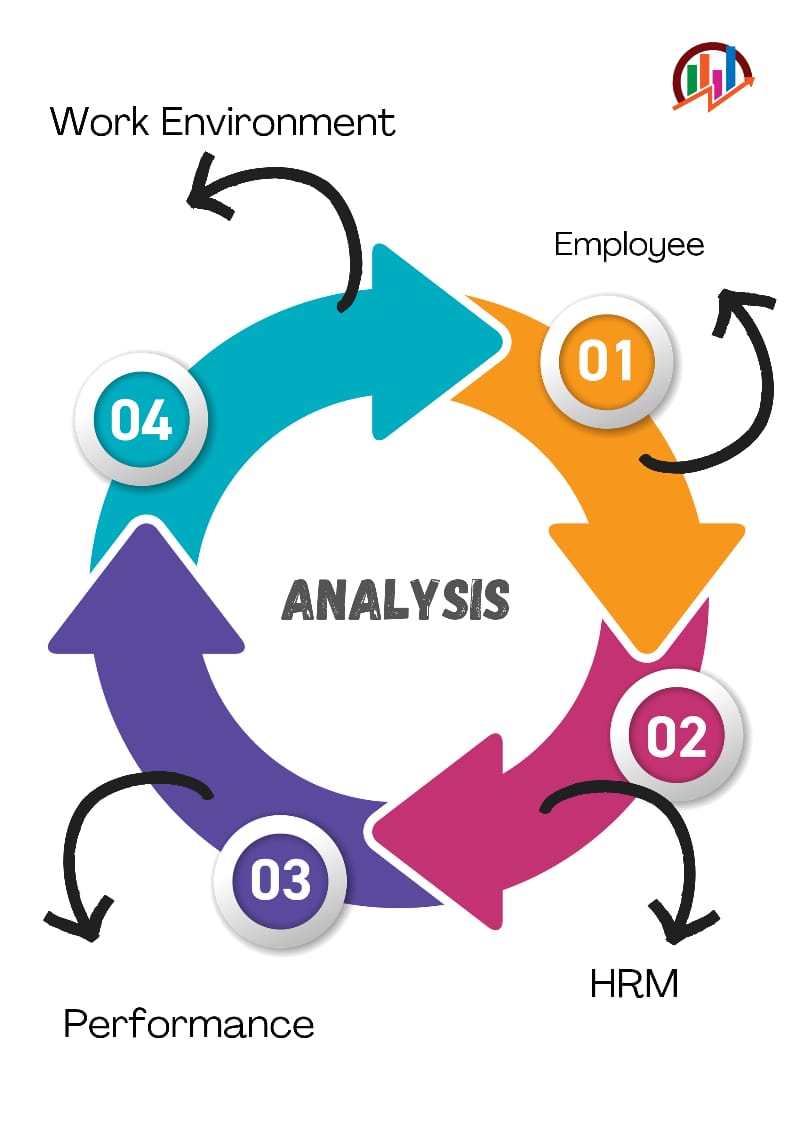Work environment analysis to improve employee performance
DOI:
https://doi.org/10.61650/rjme.v1i2.328Keywords:
Employee, HRM, Performance, Work environmentAbstract
Working environmental conditions have a significant influence on employee performance. This research aims to analyze how the work environment at the East Java Cooperative and SME Training UPT Office affects employee performance. The research method used is descriptive qualitative with data collection techniques through in-depth interviews, participant observation, and documentation. The main informants consisted of 10 employees selected based on certain criteria. The research results show that a clean, bright, peaceful, and safe work environment, as well as office facilities such as air conditioning, Wi-Fi, and other important equipment, play a significant role in increasing employee motivation and performance. Apart from that, good working relationships between superiors and subordinates also make a positive contribution to performance. The implications of this research show that improving the physical and social work environment can improve employee performance significantly and sustainably.
Downloads
References
Alananzeh, O. A. (2023). The Impact of Job Stability, Work Environment, Administration, Salary and Incentives, Functional Justice, and Employee Expectation on the Security Staff’s Desire to Continue Working at the Hotel. Journal of Statistics Applications and Probability, 12(2), 425–439. https://doi.org/10.18576/jsap/120209
Argus, M. (2021). Effects of the COVID-19 lockdown on musculoskeletal pain, physical activity, and work environment in Estonian office workers transitioning to working from home. Work, 69(3), 741–749. https://doi.org/10.3233/WOR-210033
Arkow, P. (2020). Human–Animal Relationships and Social Work: Opportunities Beyond the Veterinary Environment. Child and Adolescent Social Work Journal, 37(6), 573–588. https://doi.org/10.1007/s10560-020-00697-x
Aruldoss, A. (2022). The relationship between work–life balance and job satisfaction: moderating role of training and development and work environment. Journal of Advances in Management Research, 19(2), 240–271. https://doi.org/10.1108/JAMR-01-2021-0002
Aust, B. (2023). How effective are organizational-level interventions in improving the psychosocial work environment, health, and retention of workers? A systematic overview of systematic reviews. Scandinavian Journal of Work, Environment and Health, 49(5), 315–329. https://doi.org/10.5271/sjweh.4097
Ayoko, O. B. (2020). The physical environment of office work: Future open plan offices. Australian Journal of Management, 45(3), 488–506. https://doi.org/10.1177/0312896220921913
Bauwens, R. (2020). Teachers’ acceptance and use of digital learning environments after hours: Implications for work-life balance and the role of integration preference. Computers in Human Behavior, 112. https://doi.org/10.1016/j.chb.2020.106479
Bettencourt, A. P. (2020). Nurse staffing, the clinical work environment, and burn patient mortality. Journal of Burn Care and Research, 41(4), 796–802. https://doi.org/10.1093/jbcr/iraa061
Blanco-Encomienda, F. J. (2020). Association between Work-Related Rumination, Work Environment and Employee Well-Being: A Meta-Analytic Study of Main and Moderator Effects. Social Indicators Research, 150(3), 887–910. https://doi.org/10.1007/s11205-020-02356-1
Bouw, E. (2021). Designable elements of integrative learning environments at the boundary of school and work: a multiple case study. Learning Environments Research, 24(3), 487–517. https://doi.org/10.1007/s10984-020-09338-7
Chafi, M. B. (2022). Post-pandemic office work: Perceived challenges and opportunities for a sustainable work environment. Sustainability (Switzerland), 14(1). https://doi.org/10.3390/su14010294
Elbejjani, M. (2020). Work environment-related factors and nurses’ health outcomes: A cross-sectional study in Lebanese hospitals. BMC Nursing, 19(1). https://doi.org/10.1186/s12912-020-00485-z
Evanoff, B. A. (2020). Influence of work organization and work environment on missed work, productivity, and use of pain medications among construction apprentices. American Journal of Industrial Medicine, 63(3), 269–276. https://doi.org/10.1002/ajim.23078
Galanakis, M. D. (2022). Positive psychology in the working environment. Job demands-resources theory, work engagement and burnout: A systematic literature review. Frontiers in Psychology, 13. https://doi.org/10.3389/fpsyg.2022.1022102
Glaser, J. (2020). Preventing kidney injury among sugarcane workers: Promising evidence from enhanced workplace interventions. Occupational and Environmental Medicine, 77(8), 527–534. https://doi.org/10.1136/oemed-2020-106406
Harvey, C. (2020). Nurses’ views on workload, care rationing and work environments. Journal of Nursing Management, 28(4), 912–918. https://doi.org/10.1111/jonm.13019
Havaei, F. (2020). The impact of workplace violence on medical-surgical nurses’ health outcome: A moderated mediation model of work environment conditions and burnout using secondary data. International Journal of Nursing Studies, 109. https://doi.org/10.1016/j.ijnurstu.2020.103666
Jung, M. (2020). Impact of work environment and occupational stress on safety behavior of individual construction workers. International Journal of Environmental Research and Public Health, 17(22), 1–21. https://doi.org/10.3390/ijerph17228304
Kalra, A. (2021). Effect of internal competitive work environment on working smart and emotional exhaustion: the moderating role of time management. Journal of Business and Industrial Marketing, 36(2), 269–280. https://doi.org/10.1108/JBIM-02-2019-0094
Kim, K. (2022). Work-in-progress - The Effect of Students’ Perceptions on Intention to use Metaverse Learning Environment in Higher Education. Proceedings of 2022 8th International Conference of the Immersive Learning Research Network, ILRN 2022. https://doi.org/10.23919/iLRN55037.2022.9815996
Knardahl, S. (2022). Working at home and expectations of being available: effects on perceived work environment, turnover intentions, and health. Scandinavian Journal of Work, Environment and Health, 48(2), 99–108. https://doi.org/10.5271/sjweh.3996
Lai, Y. (2020). Work-Related Aggression in Home-Based Working Environment: Experiences of Migrant Domestic Workers in Hong Kong. American Behavioral Scientist, 64(6), 722–739. https://doi.org/10.1177/0002764220910227
Lewandowska, K. (2020). Impact of alarm fatigue on the work of nurses in an intensive care environment—a systematic review. International Journal of Environmental Research and Public Health, 17(22), 1–14. https://doi.org/10.3390/ijerph17228409
López-Pellisa, T. (2021). Collaborative writing at work: Peer feedback in a blended learning environment. Education and Information Technologies, 26(1), 1293–1310. https://doi.org/10.1007/s10639-020-10312-2
Maâ€TMmari, Q. A. L. (2020). Fatigue, burnout, work environment, workload and perceived patient safety culture among critical care nurses. British Journal of Nursing, 29(1), 28–34. https://doi.org/10.12968/bjon.2020.29.1.28
Martignoni, D. (2021). It did not work? Unlearn and try again—Unlearning success and failure beliefs in changing environments. Strategic Management Journal, 42(6), 1057–1082. https://doi.org/10.1002/smj.3261
Melnick, E. R. (2023). Funding Research on Health Workforce Well-being to Optimize the Work Environment. JAMA, 329(14), 1145–1146. https://doi.org/10.1001/jama.2023.2073
Müller, F. A. (2021). Blended learning environments that work: An evidence-based instructional design for the delivery of qualitative management modules. International Journal of Management Education, 19(3). https://doi.org/10.1016/j.ijme.2021.100530
Murphy, F. (2016). Wastewater Treatment Works (WwTW) as a Source of Microplastics in the Aquatic Environment. Environmental Science and Technology, 50(11), 5800–5808. https://doi.org/10.1021/acs.est.5b05416
Pagán-Castaño, E. (2020). Wellbeing in work environments. Journal of Business Research, 115, 469–474. https://doi.org/10.1016/j.jbusres.2019.12.007
Persson, M. (2022). Caregivers’ use of robots and their effect on work environment–a scoping review. Journal of Technology in Human Services, 40(3), 251–277. https://doi.org/10.1080/15228835.2021.2000554
Pineda, E. (2021). Improving the school food environment for the prevention of childhood obesity: What works and what doesn’t. Obesity Reviews, 22(2). https://doi.org/10.1111/obr.13176
Piszczek, M. M. (2020). HR policy attribution: Implications for work-family person-environment fit. Human Resource Management Review, 30(2). https://doi.org/10.1016/j.hrmr.2019.100701
Rainbow, J. G. (2020). Nurse Health, Work Environment, Presenteeism and Patient Safety. Western Journal of Nursing Research, 42(5), 332–339. https://doi.org/10.1177/0193945919863409
Reinhardt, A. C. (2020). Why nurses stay: Analysis of the registered nurse workforce and the relationship to work environments. Applied Nursing Research, 55. https://doi.org/10.1016/j.apnr.2020.151316
Renzo, M. Di. (2020). Smart Radio Environments Empowered by Reconfigurable Intelligent Surfaces: How It Works, State of Research, and the Road Ahead. IEEE Journal on Selected Areas in Communications, 38(11), 2450–2525. https://doi.org/10.1109/JSAC.2020.3007211
Saleem, Z. (2020). Workplace Violence and Employee Engagement: The Mediating Role of Work Environment and Organizational Culture. SAGE Open, 10(2). https://doi.org/10.1177/2158244020935885
Sio, S. De. (2020). Work-related stress risk and preventive measures of mental disorders in the medical environment: An umbrella review. European Review for Medical and Pharmacological Sciences, 24(2), 821–830. https://doi.org/10.26355/eurrev_202001_20065
Stasio, S. De. (2020). The interplay of compassion, subjective happiness and proactive strategies on kindergarten teachers’ work engagement and perceived working environment fit. International Journal of Environmental Research and Public Health, 17(13), 1–16. https://doi.org/10.3390/ijerph17134869
Teo, S. T. T. (2020). Psychosocial work environment, work engagement, and employee commitment: A moderated, mediation model. International Journal of Hospitality Management, 88. https://doi.org/10.1016/j.ijhm.2019.102415
Tleuken, A. (2022). Effects of the residential built environment on remote work productivity and satisfaction during COVID-19 lockdowns: An analysis of workers’ perceptions. Building and Environment, 219. https://doi.org/10.1016/j.buildenv.2022.109234
Ulrich, B. (2022). National Nurse Work Environments-October 2021: A Status Report. Critical Care Nurse, 42(5), 58–70. https://doi.org/10.4037/ccn2022798
Wang, Q. (2021). Fruit-battery-inspired self-powered stretchable hydrogel-based ionic skin that works effectively in extreme environments. Journal of Materials Chemistry A, 9(7), 3968–3975. https://doi.org/10.1039/d0ta09149a

Published
How to Cite
Issue
Section
License
Copyright (c) 2023 Revenue Journal: Management and Entrepreneurship

This work is licensed under a Creative Commons Attribution-ShareAlike 4.0 International License.
Deprecated: json_decode(): Passing null to parameter #1 ($json) of type string is deprecated in /home/assyfaco/journal.assyfa.com/public_html/plugins/generic/citations/CitationsPlugin.inc.php on line 49




